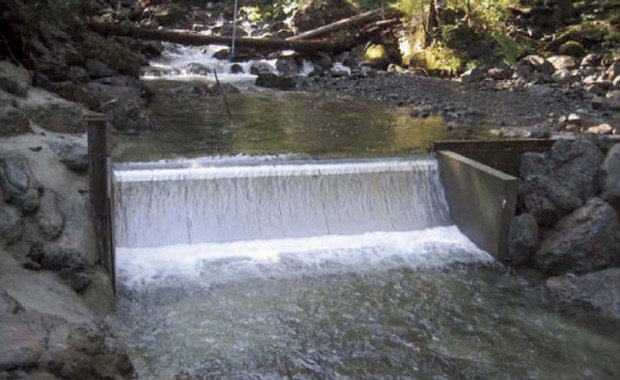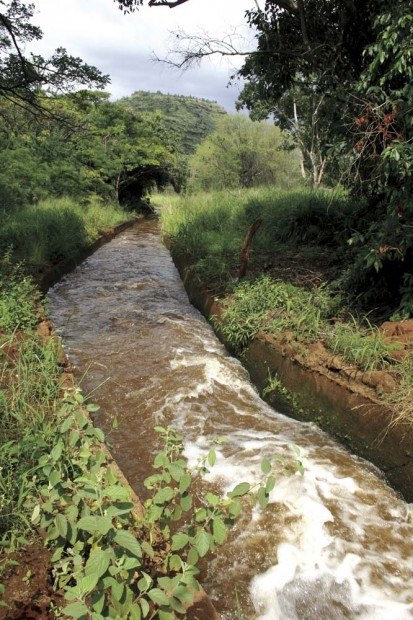LIHU‘E — Renewable and sustainable don’t necessarily go hand in hand in Kaua‘i’s 100-year legacy of hydroelectric power, according to two biologists on the island. “If hydropower is your number one goal, you’re going to maximize it at a cost
LIHU‘E — Renewable and sustainable don’t necessarily go hand in hand in Kaua‘i’s 100-year legacy of hydroelectric power, according to two biologists on the island.
“If hydropower is your number one goal, you’re going to maximize it at a cost to everything else,” said biologist Don Heacock, from the state Department of Land and Natural Resources. “Although hydroelectric is relatively nonpolluting compared to fossil fuel or nuclear energy, hydropower does not produce energy without environmental costs.”
As Kaua‘i Island Utility Cooperative goes forward in its exploration of hydropower development, local environmentalists, such as Heacock and Surfrider Kaua‘i Chairman and marine biologist Carl Berg, are calling for an environmentally holistic watershed approach.
“In the recent ‘KIUC Currents,’ (KIUC CEO David Bissell) is stated as saying, ‘Hydro is a legacy project that will provide environmentally safe power for generations,’” Berg said. “This is false. Hydro is not necessarily environmentally safe. In fact, it has the greatest potential danger to directly destroy native Hawaiian ecosystems of any form of electricity generation. The danger is to Hawaiian streams and estuaries and the unique communities, including species on the endangered species list, that comprise those ecosystems.”
Heacock and Berg said Kaua‘i has had a legacy of ecosystem destruction from plantations diverting water for agricultural and hydro use, drying out portions of streams and prohibiting animals to move freely.
“The island’s hydro power facilities were not built or designed with fish in mind, Heacock said. “It wasn’t even given a thought. They wanted to maximize sugar production.”
In a typical small-scale hydroelectric power set up, water in a river is diverted into a channel by a diversion weir, which may be a cement half-wall type of structure, often designed to ensure flow to the hydroelectric facility when water levels are low. Excess water flows over the wall and back into the river.
Through the channel, the diverted water flows to a tank called a forebay, which is retrofitted with a an automated fish screen that lifts fish and woody debris out of the river and onto land before reaching the penstock.
A penstock is a steel pipe than spans from a high to a low elevation so that the water can pick up energy-producing speed before hitting the turbine or waterwheel. The rotation of the shaft of the turbine operates an electricity generator. After passing through the turbine, the high-velocity water, called a tailrace, is shot into an output channel that may eventually feed back into the river.
“Stream diversions and weirs block the upstream migration of amphidromous species,” such as the native goby, Heacock said. “Amphidromy means they migrate twice, up and down the river, in their lifetime. Water is life, so if you alter it you alter the life in it.”
Goby migrate down river to spawn. Their larvae are then carried out to sea where they travel with currents and gradually develop. After several months, the juveniles, search out fresh water and travel up rivers to water shed habitats.
When river levels are low, the goby will sometimes try to travel up the tailrace of a hydro plant toward the turbine and eventually die or they may reach the weir wall only to find it dry and impassable.
“Gobies can climb waterfalls hundreds of feet high, proving there’s water,” Heacock said. “They can’t climb over a weir if it’s dry.” When water pools near a dry weir, the temperature of the stagnant water rises, which further endangers the fish.
“They’re concentrated. The warmer the water gets, the lower the dissolved oxygen, so they’re going to start asphyxiating. The warmer the water, the higher their metabolism, so they need more food but there’s less food, and they’re more crowded and you end up with mass mortalities,” he said.
But what are the chances that Kaua‘i, often touted as one of the wettest places on earth, would ever have a dry weir?
Heacock said river levels are constantly fluctuating and recalled a severe drought during the spring and summer of 1982. Berg said the “wettest place on earth” claim is a total myth.
“With global climate change, Kaua‘i has seen a dramatic reduction of annual rainfall over the past 40 years that will only get worse in the coming decades,” he said. “We must protect water in natural ecosystems.”
Migrating fish aren’t hydro’s only casualties, Heacock said. Mountain shrimp population are also impacted. Even though they don’t migrate down river, their larvae are so small that they can pass through fish screens and end up in high-pressure penstocks and turbines.
Although an environmental impact study for the Hanalei River says larvae can pass through a penstock and turbine unharmed, Heacock insists that there is no data anywhere to suggest this is true.
For the island’s seven existing hydro facilities, he said there are ways to retrofit them that would probably allow them to produce more power and require less maintenance. Such alterations may qualify for federal funding, he said, which would be a “win-win” for everybody.
Heacock and Berg believe new small-scale hydro projects might be environmentally and culturally appropriate on Kaua‘i, but only if environmental and cultural concerns are paramount in any decisions on water use.
“We could build them, I believe, to where we could minimize a lot of these impacts, but you have to look at it from multiple objectives — not just conserve the native fish, we need to restore them,” Heacock said. “We need optimal watershed health.”
Berg said, “The State of Hawai‘i Council of Water Resource Management needs to establish stream flow standards for the entire length of all streams that are being proposed for alteration. This is the first step. They are the only ones that have the authority and expertise to determine appropriate shared use of these public resources.”
• Vanessa Van Voorhis, staff writer, can be reached at 245-3681 (ext. 251) or by emailing vvanvoorhis@thegardenisland.com.




